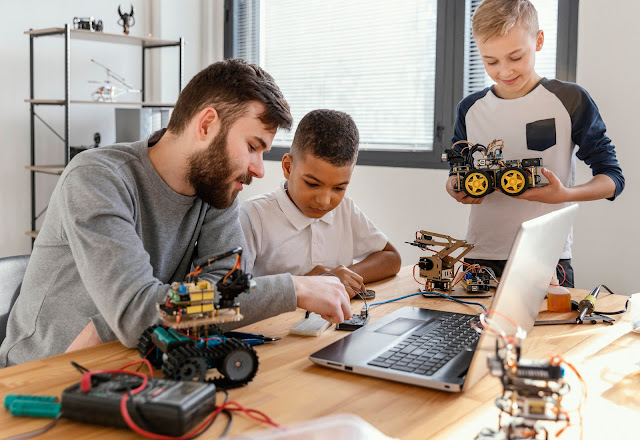Robotics for Kids: A Complete 2024 Guide for Parents
 |
| Future robot engineer in the making! #roboticsforkids |
If you answered yes to any of these questions, then this blog post is for you. In this post, we will cover everything you need to know about robotics for kids, such as:
- What is a robot and what is robotics?
- Why is robotics important and what are the applications of robots?
- What is the future of robotics and what are the opportunities for robotics jobs?
- What is robotics for kids and what are the benefits of robotics for kids?
- How can kids start robotics and what is the right age for kids to learn about robots?
What is a robot and what is robotics?
A robot is an intelligent machine that can perform a specific task following human instructions or autonomously. A robot has the ability to sense, process, and act on information. Nowadays, robots have taken their place from our home to another planet, Mars.
Robotics is the science and engineering of designing, building, programming, and operating robots. Robotics involves computer science, engineering, and mathematics. The main goal of robotics is to make human life more comfortable and to support and aid humans in various tasks.
Why is robotics important and what are the applications of robots?
Robotics is important because it can improve the quality of life, enhance productivity, solve problems, and create new possibilities. Robotics can also inspire curiosity, creativity, and innovation in people, especially in children.
Robots can be used in almost any industry or field of work. You can find robots in healthcare, manufacturing, agriculture, defense, entertainment, education, and more. Robots can perform tasks that are difficult, dangerous, or tedious for humans, such as surgery, assembly, harvesting, combat, and cleaning.
What is the future of robotics and what are the opportunities for robotics jobs?
The future of robotics is a topic of great interest and debate. Many studies predict that robots will have a significant impact on the economy, society, and the workforce. For example, PwC estimates that robots could automate up to 30% of jobs by the early 2030s. McKinsey forecasts that automation will change the demand for different skills, reducing the need for physical and manual tasks by 18% and basic cognitive tasks by 28% in Europe by 2030. A Brookings survey reveals that 52% of adult internet users expect robots to do most of the human work within 30 years.
However, the future of robotics is not only about challenges but also about opportunities. Robots can also create new jobs, new markets, new services, and new solutions. Robots can also enhance human capabilities, augment human intelligence, and empower human creativity. Robots can also collaborate with humans, learn from humans, and coexist with humans.
Some of the skills and jobs that will be in high demand in the future of robotics are:
- Robotics Engineering: Designing, building, testing, and maintaining robots and robotic systems.
- Robotics Programming: Developing, debugging, and optimizing software and algorithms for robots and robotic systems.
- Robotics Research: Conducting experiments, analysis, and innovation in robotics and related fields, such as artificial intelligence, machine learning, computer vision, and natural language processing.
- Robotics Education: Teaching, mentoring, and training students, professionals, and the public about robotics and its applications.
- Robotics Entrepreneurship: Creating, launching, and managing new ventures and businesses in robotics and its domains.
What is robotics for kids and what are the benefits of robotics for kids?
Robotics for kids refers to programmes or activities designed to teach them about the principles of robotics, including engineering, programming, and problem-solving through hands-on experience with robotics projects. The programmes are developed in such a way that they help kids build critical thinking, creativity, and problem-solving skills.
Robotics for kids can be fun, engaging, and educational. Kids can learn how to design, build, and program their own robots using various tools and materials. Kids can also explore different types of robots, such as wheeled robots, humanoid robots, animal robots, and more. Kids can also participate in robotics competitions, exhibitions, and events to showcase their skills and achievements.
Robotics for kids has many benefits for kid's development, learning, and future. Here are some of the benefits of robotics for kids:
- Robotics for kids can spark kid's interest and curiosity in STEM fields, which are essential for the future of innovation and society.
- Robotics for kids can enhance their skills and knowledge in various subjects, such as math, science, engineering, and computer science.
- Robotics for kids can improve their abilities and habits in problem-solving, critical thinking, logical reasoning, and creativity.
- Robotics for kids can boost kid's confidence and self-esteem, as they can see the results of their efforts and achievements.
- Robotics for kids can foster their collaboration and communication skills, as they can work with other kids, mentors, and experts in robotics.
How can kids start robotics and what is the right age to learn about robots?
If you are a parent who wants to help your kid start learning robotics, you might be wondering how to do it. Here are some of the steps that you can follow to start robotics for kids:
- Find out your kid’s interest and level in robotics. Ask your kid what robots they like, want to learn, and want to make. Assess your kid’s skills and knowledge in math, science, engineering, and computer science.
- Choose a suitable robotics course or kit for your kid. Browse online or visit a local store to find one that matches your kid’s interest and level. Read reviews, ratings, and feedback from other parents and kids.
- Set up a space and time for your kid to learn and play with robotics. Create a comfortable and safe space for your kid’s robotics projects. Schedule a regular and consistent time for your kid’s robotics learning and playing. Join your kid or let them learn and play independently, depending on their preference and need.
- Encourage and support your kid’s learning and progress in robotics. Praise your kid’s efforts and achievements, ask questions and give feedback, help your kid overcome challenges and difficulties, and celebrate your kid’s successes and milestones. Connect your kid with other kids, mentors, and experts in robotics, such as through online forums, communities, and events.
There is no fixed age for kids to learn about robots. Age is just a number; age is not a parameter that can be considered for learning anything (not even robotics). To learn something, you need to be interested. It’s more like how children learn any language—the sooner they start, the easier it is.
However, some experts suggest that the ideal age for kids to start learning about robots is between 6 and 12 years old. This is because this is the age when kids are curious, eager, and receptive to new things. This is also the age when kids can grasp the basic concepts of robotics, such as sensors, motors, and programming.
Conclusion
Robotics for kids is a great way to introduce your kid to the fascinating and exciting world of robotics. Robotics for kids can help your kid develop essential skills, knowledge, and attitudes for the future. Robotics for kids can also spark your kid’s interest and curiosity in STEM fields and gain hands-on experience with cutting-edge technology.
This blog post has helped you understand the basics of robotics, the importance of robotics, the applications of robots, the future of robotics, and robotics for kids. We also hope that this blog post has provided you with some of the best resources and tips to get started with robotics for kids.
If you want your kids to learn robotics or coding from a STEM-certified course, don’t miss this opportunity to book a free demo class. Click here to register now.
 |
| Look at that concentration! Building robots is a fun way to learn about STEM |
.png)

.png)
Comments
Post a Comment